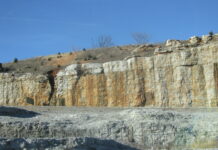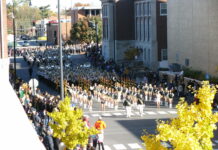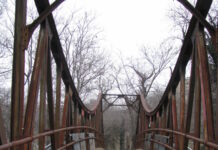Photo credit: DiasporaEngager (www.DiasporaEngager.com).
The two remaining survivors of the 1921 Tulsa race massacre, thought to be the worst single act of white supremacist violence against African Americans in US history, attended a momentous hearing on Tuesday. The supreme court of Oklahoma considered an appeal in what is almost certainly the women’s final shot at reparative justice.
Lessie Benningfield Randle, dressed all in black, and Viola Fletcher, huddled under a mauve woollen blanket, listened intently as lawyers engaged in technical legal arguments for almost two hours. It was no small feat, given that both women are 109.
Mother Randle and Mother Fletcher, as they are known, were just children on 31 May 1921, when over a period of 24 hours, about 300 Black Tulsans were murdered by a rampaging white mob.
Forty blocks of the Greenwood neighborhood – so thriving at the time that it was dubbed Black Wall Street – were bombed from the air and razed to the ground.
More than 100 lawsuits have been filed over the years since then, seeking redress for the terrible events, which left 9,000 Black residents homeless and drove an entire community into destitution. But not one survivor has ever had their day in court until now.
In a joint statement before the proceedings began, Randle and Fletcher said that they were grateful that their “now-weary bodies have held on long enough to witness an America, and an Oklahoma, that provides race massacre survivors with the opportunity to access the legal system”.
They added: “Many have come before us who have knocked and banged on the courthouse doors, only to be turned around.”
The case, which was launched almost four years ago, calls for land and property that was destroyed or stolen to be returned to survivors and their descendants. It has been drawn out for so long that it has come too late for its third plaintiff, Fletcher’s younger brother Hughes Van Ellis, who died last October, aged 102.
On the centenary of the massacre in 2021, Van Ellis testified to Congress, pleading in vain: “Please do not let me leave this earth without justice, like all the other massacre survivors.”
Now it was the turn of Randle and Fletcher to make the same plea. Their lawyer, Damario Solomon-Simmons, underlined the urgency of the moment.
“We want these survivors to see justice in their lifetime,” he told the panel of judges.
The nine supreme court justices were asked to decide whether the survivors’ complaint should be allowed to proceed to discovery, and potentially to trial. The suit argues that the damage inflicted by the massacre on the Black community in Tulsa has never been redressed, and that there should be some form of restitution by handing back property, whether in the form of land or buildings, to the people from whom it was removed.
Last July, Caroline Wall, a district judge in Tulsa county, dismissed the legal action. She had previously ruled that the case should be allowed to proceed, but then reversed her decision – prompting Tuesday’s appeal.
The outcome of the oral arguments will be watched closely across the US as one of the most advanced litigation efforts seeking amends for historic injustices. In recent decades, scores of reparations challenges have been brought before US courts, but very few have had any traction.
“The fact that the Tulsa massacre case has been allowed to proceed to this point makes it stand out,” said Carlton Waterhouse, a reparations scholar at Howard University school of law.
Should the case ultimately reach trial, Waterhouse predicted, it would encourage others to explore “creative and novel approaches to right historic wrongs through the law”.
The historic nature of the survivors’ challenge was played out in the layout of the courtroom. About 15ft away from the two surviving women, gathered at a heavy oak table, were the lawyers representing the five defendants in the case.
They include the city of Tulsa, the Oklahoma military, and the sheriff of Tulsa county.
Randle and Fletcher’s claim is that these public entities not only failed to prevent the massacre, but they also actively facilitated it by arming, exhorting and in several cases instructing the white mob as it carried out its mass killing. In the decades since the atrocity, the complaint claims, these same public entities have failed to put right the wrongs they created, leaving the Black community of north Tulsa in ongoing distress.
Solomon-Simmons pointed out the dramatic nature of the courtroom spectacle. “On the one side, you have 109-year-old plaintiffs who are the last two survivors of the massacre,” he said, pointing to Randle and Fletcher.
“On the other side, you have the perpetrators of the massacre who for 103 years have escaped any liability and who deny to this day that they caused the destruction which these survivors witnessed with their own eyes.”
The case has been brought under the legal concept of “on-going public nuisance”. Under Oklahoma law, a public nuisance can be claimed where injury or discomfort has been caused to people including by rendering property uninhabitable.
“The defendants destroyed 1,500 properties, and many of them are still uninhabitable. Over a third of the homes and businesses destroyed during the massacre were never rebuilt and many of those people were never heard from again,” Solomon-Simmons said.
On its face, “public nuisance” appears to be a sterile lens through which to view a tragedy in which up to 300 people were slaughtered. But from the survivors’ perspective, it has the benefit of having no statute of limitations, allowing them to bring a case more than a century later.
At the time of the massacre, Greenwood, a neighborhood of more than 10,000 African Americans in the north-east of Tulsa, was one of the most affluent Black communities in the country. Then on 31 May 1921, a Black teenager, Dick Rowland, was arrested on suspicion of assaulting a white woman.
The white-owned Tulsa Tribune ran a lurid story headlined: “Nab Negro for Attacking Girl in Elevator”, along with an editorial calling on white Tulsans to “lynch a negro tonight”.
By 10pm, the Tulsa police station was overflowing with an angry white mob. Instead of practicing crowd control, police deputies incited them to “go home, get a gun, and get a [n-word]”.
The crowd, egged on by city officials, crossed the rail tracks into Black Greenwood, and went on the rampage. White pilots flew over the neighborhood dropping dynamite on Greenwood streets in one of the first aerial bombardments of a US city.
At a commemoration in Tulsa on the 100th anniversary of the massacre, Fletcher recalled what she had seen as a seven-year-old child as her family fled the violence. “People being killed. Crawling and seeing smoke. Seeing airplanes flying, and a messenger going through the neighborhood telling all the Black people to leave town,” she said.
Parts of Greenwood and North Tulsa, where most of the terrorized Black people fled, continue to be blighted to this day. Statistics compiled by Human Rights Watch underline the ongoing stark disparities, with the average life expectancy for Black Tulsans standing at 70 years and that of white Tulsans at 81 years.
The supreme court justices have reserved their ruling on the appeal, but several comments from the bench suggested some empathy with the survivors’ case. The overflowing public benches at the hearing broke into applause when one of the justices, Yvonne Kauger, noted that the Greenwood massacre was never mentioned when she was a student at high school.
“Regardless of what happens, we will make sure that will never happen again. It will be in the history books,” she said.
Another justice, Noma Gurich, took exception when a lawyer representing the Oklahoma military tried to argue that the two survivors had failed to show they had been “specially injured” by the massacre, as required under the nuisance law.
“How can there be any question that the plaintiffs haven’t been specially injured?” Gurich shot back. “I mean, did the military attack other neighborhoods in 1921?”
Attorneys for the defendants argued that the two survivors lacked standing to bring the case. The public bodies implicated in the lawsuit were exempt from being sued, they said, because there was absolute sovereign immunity for all governmental entities in 1921.
Keith Wilkes, the lawyer representing the current sheriff of Tulsa county, made the most contentious argument for the defendants. Though the events of 1921 were a “dark moment in the history of Tulsa, our state and our country”, he said, what came after was a “triumph” and claimed that Black Wall Street had been rebuilt.
But Tiffany Crutcher, a descendant of massacre survivors who attended the hearing, contested that claim, noting that Tulsa’s Black community remained blighted.Her great-grandmother, a teenager in 1921, narrowly escaped from the conflagration. Then, in 2016, her twin brother, Terence Crutcher, 40, was shot and killed by police as he was standing unarmed by his car.
“It was the same police department that killed my twin brother that helped burn down the community in 1921,” Crutcher said. “The culture hasn’t changed.”
At the end of the hearing, the justices departed without giving any indication of when they will announce their decision. Mothers Fletcher and Randle were escorted out in wheelchairs, hoping that it would not be too long.
Source: The Guardian
Featured image: Viola Fletcher, the oldest survivor of the Tulsa race massacre, in Washington DC on 19 June 2023. Photograph: Shuran Huang/The Guardian
Source of original article: The Institute of the Black World 21st Century (ibw21.org).
The content of this article does not necessarily reflect the views or opinion of Global Diaspora News (www.GlobalDiasporaNews.com).
To submit your press release: (https://www.GlobalDiasporaNews.com/pr).
To advertise on Global Diaspora News: (www.GlobalDiasporaNews.com/ads).
Sign up to Global Diaspora News newsletter (https://www.GlobalDiasporaNews.com/newsletter/) to start receiving updates and opportunities directly in your email inbox for free.































